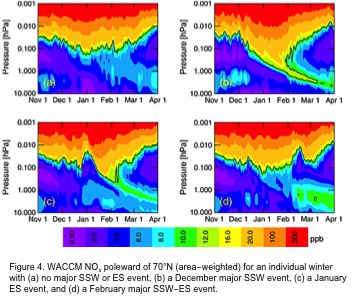New Publication
Our paper The influence of major sudden stratospheric warming and elevated stratopause events on the effects of energetic particle precipitation in WACCM was published in the Journal of Geophysical Research Atmospheres. The main result of the paper is that WACCM demonstrates a very strong relationship between the seasonal timing of sudden stratospheric warming (SSW) and elevated stratopause (ES) events and the amount of NOx that is transported to the stratosphere following the SSW or ES event.

Abstract
We investigate the influence of major sudden stratospheric warming (SSW) and elevated stratopause (ES) events in the Northern Hemisphere winter on the transport of NOx produced by energetic particle precipitation (EPP) from the mesosphere–lower thermosphere to the stratosphere using the Whole Atmosphere Community Climate Model (WACCM). Increases in NOx following a major SSW and/or ES event are in excess of 100% compared to winters when no major SSW or ES event occurred. The increase in NOx is attributed to an increase in the descending branch of the residual circulation (w*) following the event. The timing of the event strongly affects the amount of NOx that descends to the stratosphere: the earlier the event occurs, the more NOx descends to the stratosphere. We also quantify the amount of NOx produced by EPP descending to the stratosphere in each winter and find that the largest increases in NOx are in years that have a major SSW followed by an ES event early in the season (December or early January). The strength of w* following an event shows a very strong seasonal dependence and explains why the timing of the event affects the transport of NOx.




